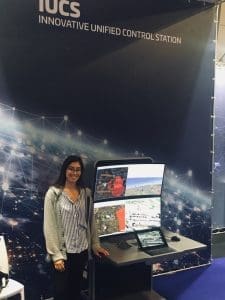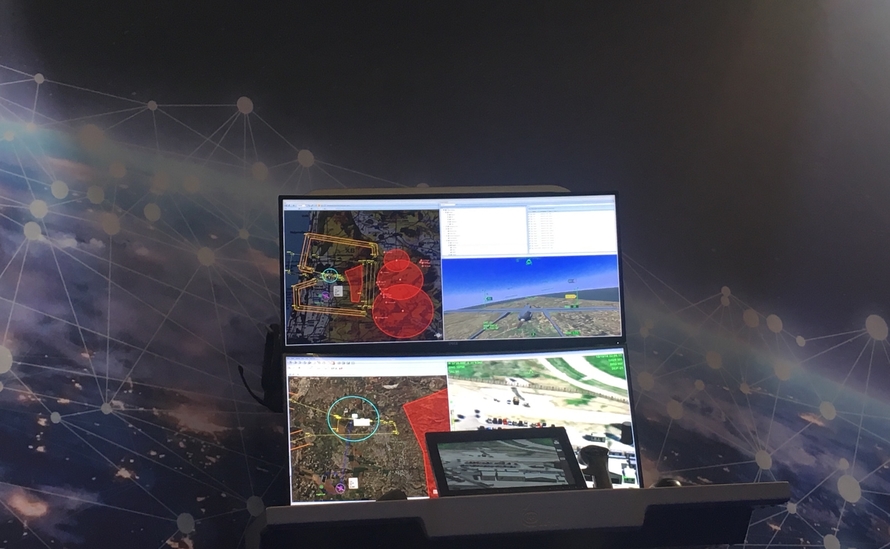This post is also available in:
 עברית (Hebrew)
עברית (Hebrew)
At the iHLS AUS&R conference last week, a wide and impressive array of unmanned systems was displayed, along with some of the most advanced technologies in the field. Among those was the Heron UAV, developed by Israel Aerospace Industries (IAI) – the most advanced model in the industry.
Just as impressive is the UAV’s command system. The command desk includes a wide display of two 34 inch screens and another smaller touch screen, bellow. Additionally, there is a control stick on the right, and another module on the left of the operator. The system is incredibly ergonomic and thought-out, tailored to its user according to the latter’s needs and comfort.
The system is called the “Advanced IUCS Innovative Unified Control Station”, and is intended in order to operate all types of platforms, and the different cameras.
IAI representatives, among them Mr. Omer Frank, an UAV operator, showcased the system and its means of operation to iHLS news desk. In addition, we were given the incredible opportunity to operate the system’s simulator ourselves, with detailed explanations from Omer.
Surprisingly – the system is very simply and easy to use, even for someone like me, meaning without professional experience. The amount of thought and human engineering that went into the development of the system is apparent immediately. The system is extremely intuitive.
When operating the system, the right hand controls the stick, while the left is in charge of the module. The system feels incredibly comfortable and fitted to the shape and movement of the human hand, without the need to reach out for any distant button.

Another aspect of the system that surprised me while using the system is the fact that most operation of the UAV, in fact, in centered around controlling and directing its camera. Operation of the camera includes a variety of different features: video, an automatic target zoom, zoom lock, different sensors and starting a separate video.
When asked about the camera, Omer explained: “for example, I can spot another UAV in flight, its camera, and proceed to lock on its targets, communicate with it and see its recommendations.”
The system can, therefore, make recommendations regarding targets, and as its operator I can choose a specific target. Once I have made my choice, the system tracks the target on its own without further interference from me, the operator.
In order to control and UAV and lead it to its destination, the operator uses either the mouse of the touch screen in order to drag the plane icon on the digital map toward its destination. Omer adds that the touch screen and the way it is incorporated into the system is unprecedented.
When I inquired about the placement of such command and control desks, Omer explained that there are several systems placed on military Hammers, and that they can additionally be placed in command and control rooms, even underground and surrounded by protective walls. Additionally, it is possible to place several desks in one room, each one focused on its own goal and operation.
“UAV’s are now incredible accessible, we are talking about thousands – it is the most common vessel. There are not enough high-end users. So, a user who is not a pilot can also use this system.”
This means that qualification on the system is not intended only for experienced and certified high-end users, especially for the reason that there are not many such users in general, let alone ones who are able to continually operate the system. In addition, it would be expensive. For this reason, the process of maintaining competency on the system is easy and simple, and the training period on its operation is short. The system’s operators can come from a variety of backgrounds, from intelligence to optics and more.
“Essentially, we omitted the focus on the user’s placement during flight, and emphasized and improved the execution of the mission with simple and intuitive means,” Omer explains. “The level of alertness of the user during typical intelligence oversight missions is relatively low. Our system can identify an occurrence on its own and alert its operator, so that the level of alertness is higher.”
“All of this – is a state of the art toolbox of what can be done today, and it is the final product. An average user, not just high-end, can use the leverage the system to its highest potential.”


























